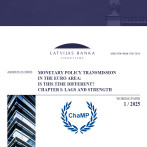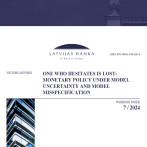What the data won’t tell you or did credit institutions’ assets really double in 2021?

In 2021, data on Latvia’s credit institutions in various sources of statistical data can be truly perplexing. Some sources would show only gradual changes in data, other – almost extreme, e.g., assets increased almost twofold, profitability halved. What exactly happened and can one trust the data? In this article we explain what should be taken into account when analysing data of Latvia’s credit institutions as of 4th quarter 2022.
In short
-
Swedbank group’s institutions in the Baltic States were reorganized by transferring shares of all subsidiaries under a holding company registered in Latvia – Swedbank Baltics AS.
-
As a result, extreme shifts in total assets and other balance sheet positions can be observed in several statistical data sources.
-
Representation of said changes can vary depending on the statistical data provider.
-
Extreme growth rates in data will remain up until 4th quarter of 2022, when the base effect will disappear.
In 2021, data on Latvia’s credit institutions in various sources of statistical data can be truly perplexing. Some sources would show only gradual changes in data, other – almost extreme, e.g., assets increased almost twofold, profitability halved. What exactly happened and can one trust the data? In this article we explain what should be taken into account when analysing data of Latvia’s credit institutions as of 4th quarter 2022.
Main reason of these mysterious changes is the reorganisation of the Swedbank group in the Baltic States and its diverse representation in statistical data sources. In October 2021, having received an approval from the ECB and other supervisory authorities, the shares of Swedbank Group banks in the Baltic States were transferred to a holding company registered in Latvia – Swedbank Baltics AS that was established at the beginning of 2021 with legal address in Latvia. Subsidiary groups of Swedbank AB (Sweden) from all three Baltic States were consolidated in the new entity.
The holding company started producing statistical reports as of 1 October 2021, and they included data on the merged Baltic entity. Thus, in the fourth quarter 2021 the value of consolidated assets of Latvian credit institutions significantly increased.
To a data analyst who is not informed on this structural change, such data could lead to misguided conclusions on dynamics of Latvian credit institution performance. This article explains the most important aspects that should be considered to analyse data of Latvian credit institutions at a consolidated level as of the fourth quarter 2021.
The holding company Swedbank Baltics AS consolidates Swedbank group entities from Latvia, Lithuania and Estonia (see Chart 1). Thus, data on the assets and profits of entities from all three Baltic States are included in Swedbank Baltics AS reports that are submitted to supervisors. Accordingly, these statistical data include assets of Swedbank AB (Lithuania) and SWEDBANK AS (Estonia) subsidiaries (at the end of 2021, the value of assets of Swedbank AS was 7.5 billion euro, while the value of assets of Swedbank Baltics AS – 40.9 billion euro). Thus, a very steep increase in assets and other balance items was observed in the statistical data year-on-year and quarter-on-quarter.
Chart 1. Structure of the Swedbank group in the Baltics (%) [1]
Note: Swedbank Group structure, according to Swedbank AB (Sweden) and Swedbank AS (Latvia), Swedbank AB (Lithuania), and SWEDBANK AS (Estonia) 2021 public reports.
Interpretation of profit indicators is even more complicated, as in the fourth quarter of 2021 reports submitted to supervisors Swedbank Baltics AS contained only earnings that were recorded only after the date when Swedbank AB (Sweden) Baltic subsidiaries and their group companies were included in the balance sheet [2], i.e. from 1 October 2021 (the profits of Swedbank AS in 2021 were 73.5 million euro, and the profits of Swedbank Baltics AS –84.8 million euro). This resulted in deviation of return on equity (ROE) and return on assets (ROA) indicators, as the share of profits recognised by the holding was indicated only for one quarter, while the equity and assets for the entire year [3]. Meanwhile, the liquidity indicators are not reported at the level of holding company; thus, statistics where they were included had data only on the Latvian Swedbank AS.
The effects of creating the holding company are less visible in the statistics of Latvijas Banka on financial accounts, household balance sheet and international investment balance sheet. In these reports, company data are not consolidated therefore they do not include all assets in Estonia and Lithuania. However, they include changes in direct investment: during the fourth quarter 2021 direct Latvian investment in Lithuania and Estonia, as well as Swedish direct investment in Latvia increased.
Thereafter, several examples of how data on Latvian credit institutions are reflected in statistics and how they would look like if the data of Latvian Swedbank were used instead of Swedbank Baltics AS data are provided [4].
European Banking institution (EBA) compiles data on the largest credit institutions that are published in the Risk Dashboard. Data on three largest credit institutions from Latvia and other Baltic States are included in the Dashboard. As of the fourth quarter 2021, Swedbank Baltics AS has also been included. This has resulted in a radical shift in indicators for the largest Latvian credit institutions: the profitability indicators (e.g. ROE) rapidly decreased, while capitalisation indicators (see Common equity Tier 1 (CETI )1 ratio in the example) grew as subsidiaries of Swedbank AB in the Baltics have a relatively high capital adequacy (see Chart 2).
Chart 2 ROE and CET1 ratio of three largest credit institutions in the EBA Risk Dashboard and in data from reports provided to supervisors
The ECB Statistical Data Warehouse also includes data on credit institutions. As of the fourth quarter of 2021, Swedbank Baltics AS has also been included in the consolidated banking data [5] available here. Thus, total assets and equity of banks reflected by data (see Chart 3) increased approximately two-fold during just one quarter, while in the supervisory reporting they would remain almost the same. Thus, by analysing time series of credit institutions and comparing them with data from other EU countries, it may be concluded that the Latvian statistics will demonstrate a very rapid increase in the balance sheet items of banks.
Chart 3 Total assets and total own funds in the consolidated banking data from the ECB Statistical Data Warehouse and in the data from reports provided to supervisors (2021; billions of euro)
However, not all data sources suffer from such data interpretation already from the fourth quarter of 2021. For instance, the sample of institutions included in the ECB banking supervision data (also published in the ECB Statistical Data Warehouse) is aligned with the range of institutions supervised by the ECB. Respectively, the date of the fourth quarter 2021 still include Swedbank AS, while as of the first quarter 2022 it is substituted by Swedbank Baltics AS that has become the subject of ECB supervision as of the beginning of 2022. Respectively, changes in these data will become visible only in 2022, and not as of the fourth quarter 2021.
After the publication of 2022 data, part of these effects will disappear, as they will have a balanced dynamics of balance sheet and earnings data. However, the speed of changes in the profit and loss items will be extreme until the fourth quarter 2022 when it will no longer be affected by the base effect.
[1] Swedbank Group structure, according to Swedbank AB (Sweden) and Swedbank AS (Latvia), Swedbank AB (Lithuania), and SWEDBANK AS (Estonia) 2021 public reports.
[2] Swedbank Baltics AS consists of the following companies – in Latvia: Swedbank AS an its subsidiaries Swedbank Līzings and Swedbank Atklātais Pensiju Fonds, in Lithuania: Swedbank AB and its subsidiaries Swedbank Lizingas, in Estonia: SWEDBANK AS and its subsidiaries SWEDBANK LIISING AS, Swedbank Support OÜ, Swedbank Life Insurance SE and Swedbank P&C Insurance AS.
[3] In 2021, in the consolidated annual report of Swedbank Baltics AS, the earnings have been annualised in the ROE and ROA calculation to provide more objective data on the profitability of the group.
[4] Data on credit institutions’ financial indicators are published on FCMC’s homepage, https://www.fktk.lv/statistika/kreditiestades/
[5] https://sdw.ecb.europa.eu/browse.do?node=9691144
Textual error
«… …»







